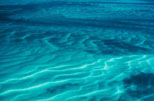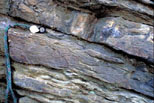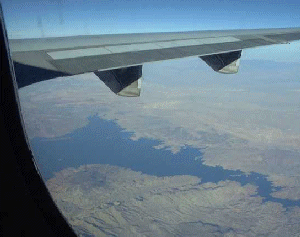Sedimentary Rocks Contain Clues to Ancient Environments
As climate changes over time, so do environments! For instance, at one time
a region might contain a lake
and river
system, but millions of years later there may be no trace of water
at all. The water may have left, but clues remain in the sediment that settled
out of the water. These traces allow us to figure out what environments
were like in the past!
Look below to see what different environments look like on the Earth today,
and what environments leave behind in sedimentary
rocks. Click on the pictures below to compare environments and the
types of rocks that are made from them.
| Environment |
Sediment Size |
What environments look like
on the Earth today: |
What environments from long
ago left behind in rock: |
| Lake |
Mud |
 |
 |
| Swamp |
Mud |
 |
 |
| Desert Dunes |
Sand |
 |
 |
| Alluvial Fan |
Sand and gravel |
 |
 |
| River |
Silt, sand, and gravel |
 |
 |
| Lagoon |
Mud |
 |
 |
| Beach |
Silt, sand, or gravel |
 |
 |
| Shallow Ocean |
Silt and sand |
 |
 |
| Deep Ocean |
Mud, with thin layers of sand or silt |
 |
 |
| Tropical Ocean |
Sediment made of Calcite (and other carbonate minerals) |
 |
 |
Last modified January 6, 2004 by Lisa Gardiner.
You might also be interested in:

Rivers are very important to Earth because they are major forces that shape the landscape. Also, they provide transportation and water for drinking, washing and farming. Rivers can flow on land or underground
...more
When water or wind slows down, sediment can no longer be carried in it. The particles of sediment fall through the water or air and form a blanket of sediment on the bottom of a river, a lake, ocean,
...more
Earth’s climate is warming quickly now. We know that this has to do with more greenhouse gases in the atmosphere and other global changes. But there is a lot we don’t yet know about how warming will change
...more
NASA’s rover, named Spirit, has landed on Mars and will soon be scouting the surface for interesting geology! Scientists are interested to know whether the place where Spirit landed was once a lake. Currently,
...more
Scientists discovered the fossils of a gigantic snake. It lived in South America 60 million years ago. It was longer than a school bus and weighed 1140 kilograms (2500 pounds). This snake was a constrictor,
...more
Looking for online content that can be used for a climate change education course or module? Pages linked below can be used to support an introductory climate change education for either a unit or a full
...more
Spotting minerals is fun! There are many different types of minerals. Each has a different name and special traits. You can learn more about minerals by looking closely at them to understand their special
...more


































